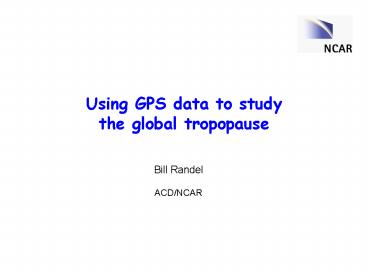Using GPS data to study the global tropopause PowerPoint PPT Presentation
1 / 39
Title: Using GPS data to study the global tropopause
1
Using GPS data to studythe global tropopause
Bill Randel ACD/NCAR
2
Vertical temperature profile
tropopause (tropics)
3
Vertical temperature profile
tropical tropopause
midlatitude tropopause
4
Latitudinal structure of the tropopause
5
Latitudinal structure of the tropopause
6
Ozone
7
The tropopause is interesting because
- boundary between stratosphere and troposphere
- (air masses with different chemical and
- dynamical characteristics)
- tropical tropopause sets boundary condition for
air - entering the stratosphere (key for water
vapor - also for short-lived chemical species)
- details of extratropical mass and chemical fluxes
poorly known - relevant for understanding climate variability
and - change (a sensitive indicator of climate
change?)
8
- GPS data are particularly useful for tropopause
studies because of their high vertical resolution
- Much of the temperature variability is on scales
- lt 5 km, poorly resolved by nadir sounding
satellites - Two science problems
- Tropical tropopause variability
- Long-term changes in global tropopause
9
Tropical tropopause temperatures
NH winter climatology
deep convection
10
Variability of tropopause temperature
11
Sample of GPS tropical temperature profiles
note enhanced variability above 15 km
12
Kelvin waves near the tropopause
eastward traveling Kelvin waves
13
Kelvin wave vertical structure
tropopause
14
Correlation of waves with transient deep
convection
wave variance at 17 km
OLR near Indonesia
15
Residual temperature variance (small scales)
16
Residual (small-scale) wave variance
17
Model simulation of gravity waves forced by deep
convection
Alexander and Holton, 2000
18
Gravity waves interacting with a critical level
19
Gravity waves interacting with a critical level
critical level
20
Residual (small-scale) wave variance
21
Long-term changes in global tropopause
- Science issues
- Is the tropopause a sensitive indicator of
climate change? - What changes have occurred, and what has caused
them? - Can we accurately model tropopause variability
(and change)?
22
Contributions of Anthropogenic and Natural
Forcing to Recent Tropopause Height
ChangesSanter et al.Science, July 2003
observations (NCEP data)
climate model with changing CO2, ozone, aerosols,
...
decrease in tropopause pressure (increase
in altitude)
23
Extratropical temperature profiles often have
multiple tropopauses
radiosonde at Charleston SC (lat 32 N)
24
statistical distribution of tropopause heights
from radiosondes at Charleston 1950-2003
25
Tropopause structure associated with
developing baroclinic wave
Shapiro, 1978
double tropopause
26
aircraft ozone measurements
27
two examples from GPS data
28
statistics at Charleston from radiosonde and GPS
data
radiosondes
GPS
29
statistics at Annette Island, AK (latitude 55 N)
GPS
radiosondes
30
seasonal variation of profiles with multiple
tropopauses
radiosondes
GPS
31
tropopause climatology from GPS data
32
Where do multiple tropopauses occur? A GPS
climatology
January
July
33
Key points
- Multiple tropopauses often occur in extratropics
- (mean tropopause is a misnomer)
- GPS statistics agree well with (isolated)
radiosondes - (can use GPS data to study global
variability) - Use caution in studying long-term variability
34
long-term variability in occurrence of
multiple tropopauses
are increases in mean height attributable to
more frequent upper-level tropopauses?
35
How do models simulate tropopause variability
(and change)?
tropopause statistics from WACCM
note absence of second peak
36
Some uses for COSMIC data
- study ubiquitous waves in UTLS
- coupling with cloud parameters and chemical data
- (e.g. NASA A-train satellite data)
- UTLS initiative at NCAR
- (HIAPER, satellites and models)
37
(No Transcript)
38
(No Transcript)
39
12 km snapshot of ozone from MOZART3
Courtesy Doug Kinnison

